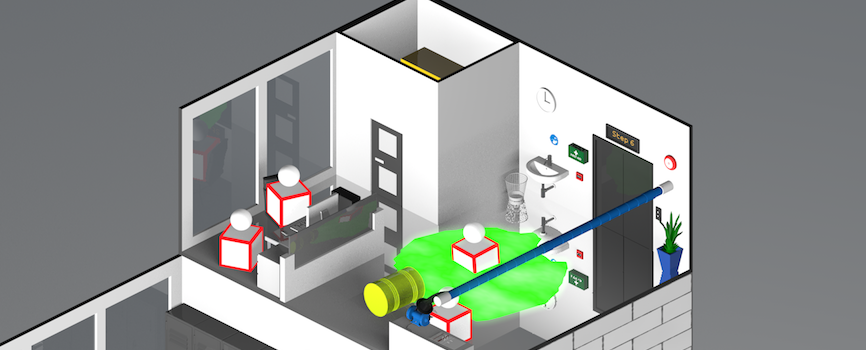The making of our Effective Remote Working Course
Posted 5 years ago
Here at iHasco, we have an incredibly talented and determined team, and in times of adversity it is important to be able to share a positive story to hopefully inspire and motivate others to succeed! Therefore read on to find out how we successfully overcame the challenge of course production during lockdown, to create something that is not only in line with the high quality of all our courses but provides enormous value to the huge number of people working remotely…

Our Effective Remote Working Training course was actually made remotely!
With 2020’s lockdown in full swing, we decided we should live up to our core values and make a genuine difference. We wanted to help our customers by creating an immediately useful Effective Remote Working training course, as businesses up and down the country were having to ask employees to work from home and adapt to this unprecedented situation. Whilst being a noble idea, with the whole team actually working from home, the obstacles to create this course were huge! In fact, it would have probably been wiser to take the course before trying to make it!
Walking the walk
So the team set to work, and by being in a position of working from home ourselves were able to intelligently assemble useful tools for individuals and businesses to implement while working remotely. Despite the restrictions, we had to work out how to go about the usual production processes with a dispersed team, in order to end up with a completed course. Also whilst ensuring we kept sight of our aim to support individuals and businesses with remote working to ensure levels of productivity remain high and stress low – two vitally important things in light of the current challenges for workers.
Research for the course was carried out in Wokingham by Carlie, the script was created in Thatcham by James, the narration was filmed in Croydon by Chris and edited together in Nottingham by Matt, extra animation was supplied from Weybridge by Ellie and unique props were brought to life in a shed in Sandhurst by me. After being used to working at Bracknell HQ together, to suddenly be scattered over 200 square miles of England was a very new and quiet experience for us! But it proved we could still work together as a team even though we were physically apart. Below are some pointers on how we did this, and you can see that all these elements form key messages from the remote working course itself.
Learn how to successfully communicate with colleagues
Everyone has had to become video conference literate over the last few months and so it was for us, utilising uploads and downloads, cloud storage and shared assets.
IT support wasn’t someone you phoned, it became something we all shared, when trying to explain to a confused colleague where on their screen the ‘microphone on’ button was hidden. Learning this new way of communication has been vital to be able to complete the course, from updates about progress to actually filming parts of the course remotely. Adapting to remote working wasn’t about changing our role, but learning to do things in a different way to get the job done. It helped that the team had a shared desire to create a valuable course to support those who have never worked remotely or ensure more adept remote workers were remaining productive and could review their working practices.
Understand the importance of creating a productive workspace
There is no perfect way to set up your workspace, however it is important to ensure your space maximises your productivity and allows you to remain focussed. Something that was also important for the making of this course! Wherever you set up, you must consider your own health, safety and wellbeing so as to avoid work-related musculoskeletal problems due to poor posture. Proper DSE set up often requires laptop risers to ensure your screen is at a safe height, but sometimes when it actually comes to creating your personal workspace, it is anything but standard.

Although the laptop has to be at the correct height for safe DSE, there’s no rule to say you can’t use your favourite cookbook to get there!

Having a clear, safe workspace for filming was also vital!
Maintaining workflow with technology
My main part in this remote team was to create stop motion animations, in the style of the 3D computer animations, used for the lion’s share of the course. Briefed by Matt Newport (Creative Manager in Nottingham) I set about making clocks, phones and brains out of cardboard to then animate them so they illustrated the home working strategies we needed.

I received my cloud based wish-list and set about cutting up some of the many delivery boxes that had mounted up over lockdown.
The process involved carving out and then photographing my understanding of what the group needed, then re-uploading the files to the web and waiting to see what the team thought of the footage. Continually sharing ideas and feedback through technology allowed me to maintain a steady flow of work and make sure that everyone’s ideas were aligned, so we could produce a high quality course.

The final result was the culmination of practising what we preach when it comes to effective remote working, not losing team spirit and ensuring creative flair is present in everything we do to ensure the key learning objectives are conveyed in a fun and meaningful way.
As remote projects go, we are incredibly proud of how the team pulled together to produce this course. We hope you agree that the making of this course proves that remote working can be incredibly effective!
See for yourselves and watch the course trailer below.
Set up a free trial for our Remote working training course today
Remote work is likely to play a further role in the future of many organisations. Therefore equip your workers with the skills they need to succeed and remain productive. You can request a no-obligation free trial here today to see what makes an iHasco course unique.

Mike Brooks
Videographer & Creative Facilitator
Related articles



Opt-in to our newsletter
Receive industry news & offers